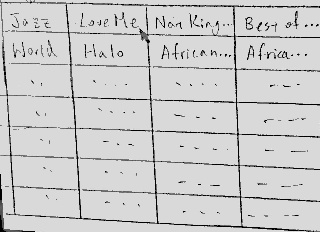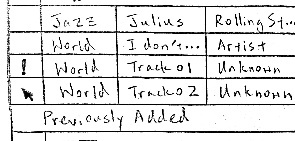Overview of Design
This is a composite design that focuses on providing users with the maximum number of functions (playback, reporting, search, custom views etc.)
- Motivation: The motivation behind this design is the desire to incorporate all the tasks and subtasks listed in our GR1 milestone. In this design we attempt to fulfill all tasks with just one application.
- Design Idea: Since most modern-day music players contain most of the functionalities mentioned in GR1, the design emulates common music play interfaces (iTunes, MediaMonkey etc.).
- Scope: From the interviews, it seems that importing new music and reporting to CMJ are the most essential tasks for a music director, while flushing old music is only secondary and can be easily achieved automatically in a digital database. As a result, KaJaM! will focus primarily on importing and reporting (first 2 tasks in GR1), as well as all of their subtasks.
- Pro: maintains externally consistency and enables users to use knowledge in the world since it is similar to common music players.
- Con: for less technically inclined users, this interface may appear to be a bit overwhelming and confusing at first.
An overview of the entire interface is shown here, details regarding each component will be explained in the storyboard below.
Storyboard
Sketch | Explanation |
|---|---|
|
|
|
|
|
|
|
|
Select the song to play |
|
Double click on song to expand to edit mode |
|
Add a new view |
|
|
|
|
|
|
|
|
|
|
|
Analysis of Design
Learnability
This design is focused on providing the most functionalities to users, hence the comprehensive interface appears to be quite crowded and busy, which decreases the learnability aspect. However, this disadvantage is mitigated by the fact that the interface is modeled after common music players such as iTunes, MediaMonkey and Spotify. This maintains external consistency, allows users to utilize knowledge in the world, and enables them to get familiar with the interface quickly.
- Importing Digital Media
- Facilitates easy learnability due to visual cues and affordances (Drag and Drop sign and Currently Importing progress bar)
- Media Playback
- Control Panel is familiar to the average user (similar to other popular music players)
- Search function is displayed prominently to help users locate specific music tracks
- Tabbed view design is modeled after popular browsers (such as Chrome, Firefox and Internet Explorer), with a "plus" button that hints strongly that users can create new views.
- Editing Track Information
- Not obvious that double-clicking on a track bring up the edit mode, maybe a hover message will be helpful to inform users of this
- Once the user enters edit mode, many affordances such as blinking cursor, custom tags and datepicker help users realize the editable fields
- Exporting CMJ List
- Export view button is displayed conspicuously on the interface, allowing new users to easily realize how to export and save a particular view for CMJ reporting.
Efficiency
The focus of this design is completeness of functions, so aspects of efficiency may have to be compromised to maintain balance with learnability of all the different functions:
- Importing Digital Media
- Importing process maximizes efficiency by allowing multiple file drag and drops.
- Users can drop a multitude of zip files all at once onto the KaJaM! interface, where they will get queued up
- Allows simultaneously importing, with the exact number customized by the user
- Importing is asynchronous, so users may start previewing and editing music tracks while they get imported
- Media Playback
- KaJaM! is focused on importing digital media instead of playback, the playback process is not designed for efficiency.
- No playlist where users can edit their current playback sequence, hence there is no way to add multiple songs to the queue
- Editing Track Information
- Editing information is performed individual for each track (cannot edit multiple tracks), exposing a major efficiency disadvantage
- This is the tradeoff between efficiency and safety, where this design leans towards safety to prevent users from accidentally changing information of multiple tracks
- Exporting CMJ List
- The exporting function is simple, fast, and omits trivial information from list generation (CMJ reports do not contain date imported and release date) to maximize efficiency.
Safety
Due to the complexity of this interface, we decided to favor safety aspects of the design over efficiency to prevent user errors midst confusion. Many features of the interface emphasize safety:
- Importing Digital Media
- Importing feature has been designed to maximize efficiency through multiple uploads, but it is also safe because we prevent accidental importing by allowing users to cancel the import at any time
- Hovering over a current import will bring up a "delete" button which will cease the import process and dequeue the file
- Once the file finishes importing, there is no way to delete the album except through individual removal of the tracks
- Possible improvement would involve an "undo import" function which effectively removes all imported music from the library
- Media Playback
- Playback control panel allows for easy adjustment of play, pause, previous, next, as well as position in the current playing song
- All user mistakes are recoverable by simply dragging the cursor back or using the playback buttons
- Editing Track Information
- Safety is a primary concern for editing track information
- Double clicking on any track brings the user into the edit mode, which is made obvious by expanding the track into a view with album, genre tags, as well as individual editable fields
- User can directly edit each field, but the undo function is still applicable in the application, hence tolerating a certain degree of user errors
- As mentioned in the "efficiency" section, we decided to disallow multi-track editing to avoid user mistakes propagating to a large number of tracks
- Exporting CMJ List
- The exporting view function prevents user errors by first giving users a preview of the view to be exported
- User have to "confirm" and actually save the CMJ list view to disk
- At any time, if the user notices an error in the export, the "cancel" option is available to return the user back to the main KaJaM! interface.
...
Task
...
Sub-Task
...
Sketch
...
Description
...
Learnability
...
Efficiency
...
Safety
...
Importing Digital Media
...
Logging into KaJaM! System
...
...
...
...
...
...
...
Drag and drop downloaded zip files
...
...
...
...
...
...
...
Viewing the file import queue
...
...
...
...
...
...
Curating Digital Media
...
Playing the imported album
...
...
...
...
...
...
...
Creating a view (to edit a subset of the library only)
...
...
...
...
...
...
...
Verifying and editing album information
...
...
...
...
...
...
...
Searching the library
...
...
...
...
...
...
...
Delegating tasks to elves (or bookmarking things for future curation)
...
...
...
...
...
...
Reporting to CMJ
...
Sorting a view by a column header (Play Count)
...
...
...
...
...
...
...
Creating a custom column header (Filtering)
...
...
...
...
...
...
...
Exporting a view
...
...
...
...
...
...
...
Saving a view
...
...
...
...
...















